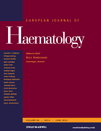Severe idiopathic erythroblastic synartesis: successful treatment with the anti-CD20 monoclonal antibody rituximab
Abstract
Erythroblastic synartesis is a very rare disorder, considered to be caused by autoimmune mechanisms, leading to aggregation of erythroid precursor cells in the bone marrow and subsequently to acquired dyserythropoiesis with severe, transfusion-dependent anemia. An association with lymphoproliferative or autoimmune diseases has been reported or strongly suggested in all six published cases. Here, we report a young patient with severe idiopathic erythroblastic synartesis without an underlying disease, who was successfully treated with rituximab, an anti-CD20 monoclonal antibody. The patient received rituximab at a dose of 375 mg/m2 once weekly for 4 wk after failure of both immunosuppressive therapies with corticosteroids and intravenous immunoglobulins. At a follow-up of 30 months after treatment, the patient is still in continuous complete remission without any further treatment, suggesting that rituximab may induce prolonged remissions and eventually cure in this rare disease.




